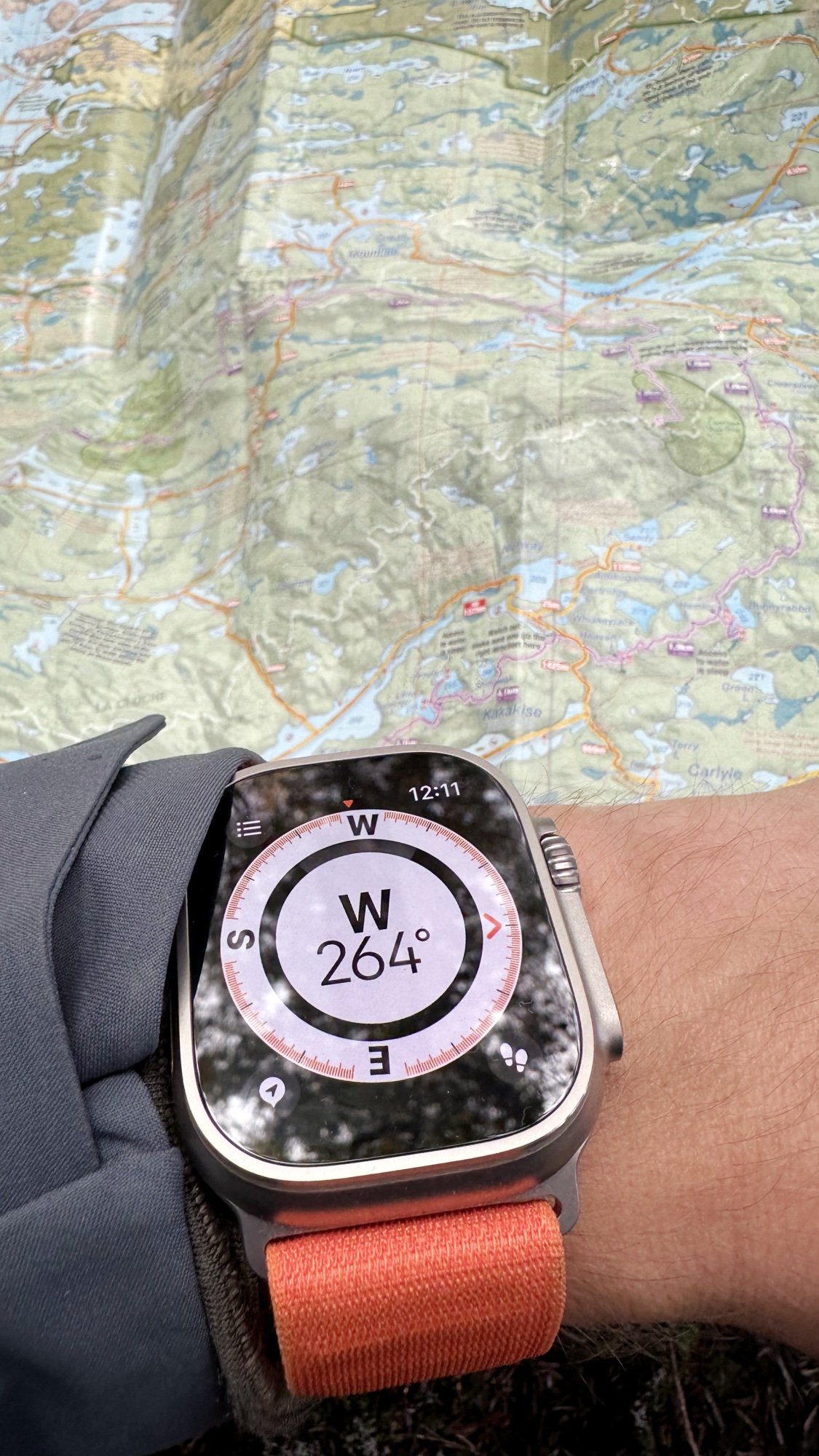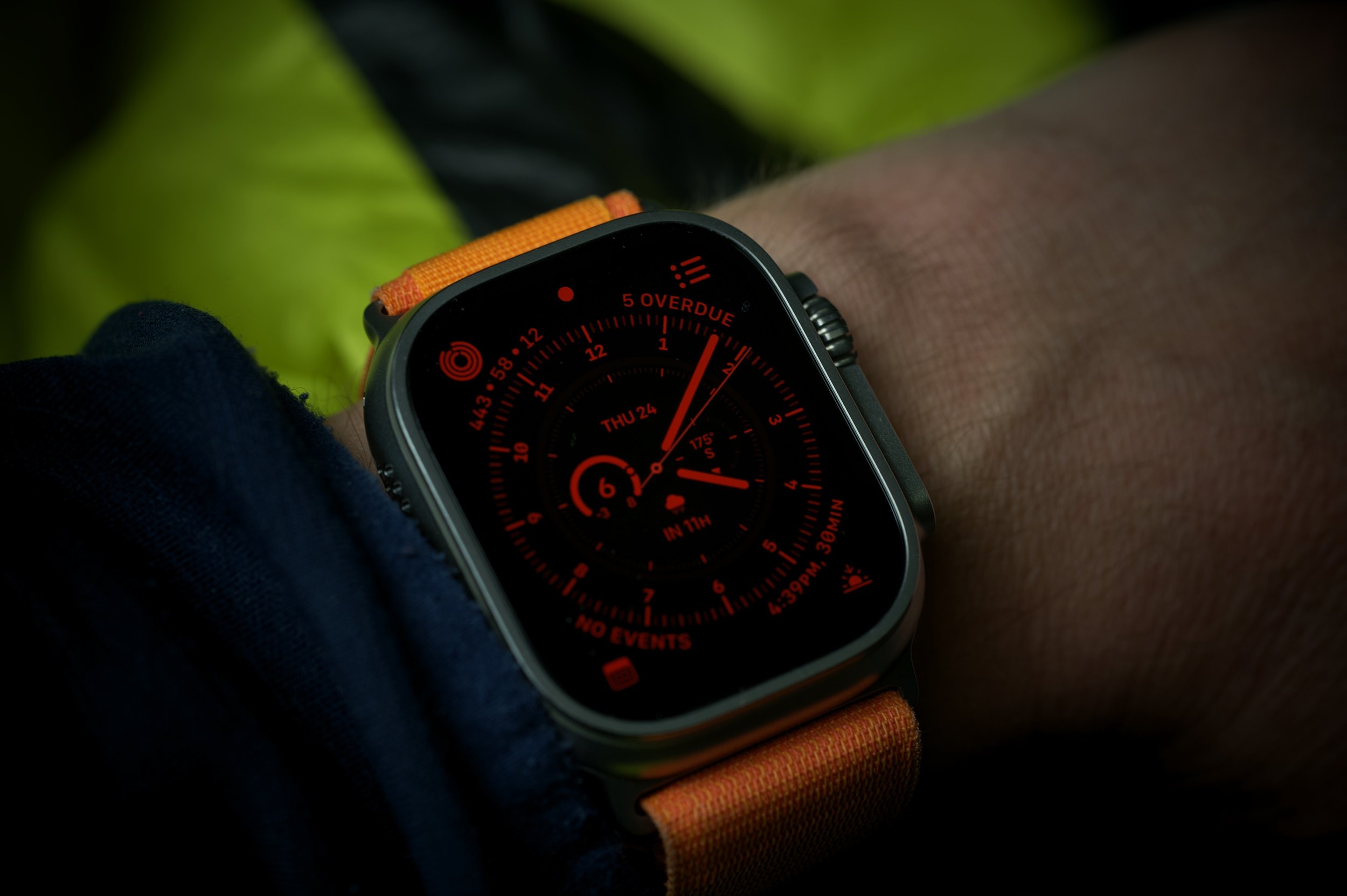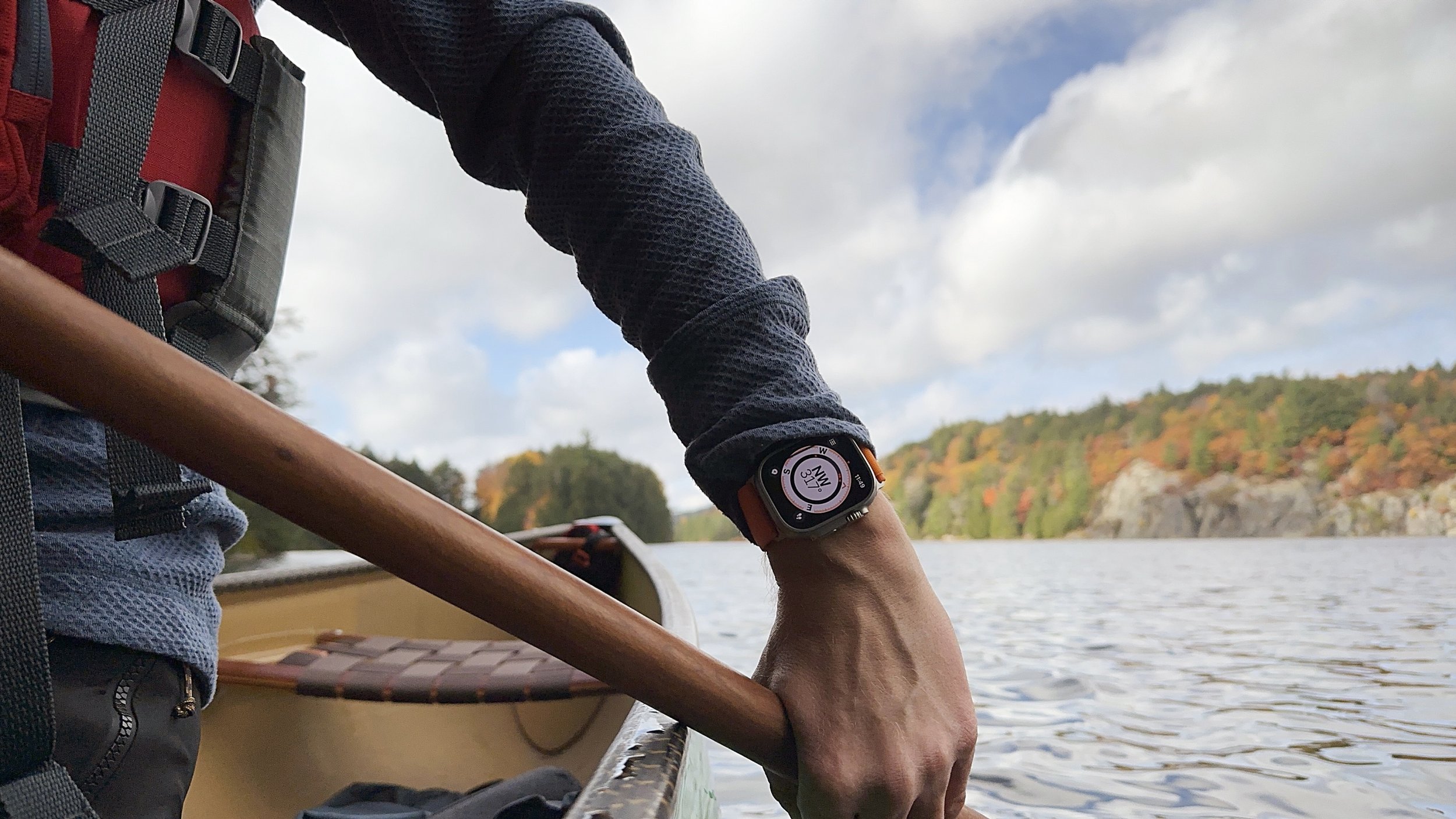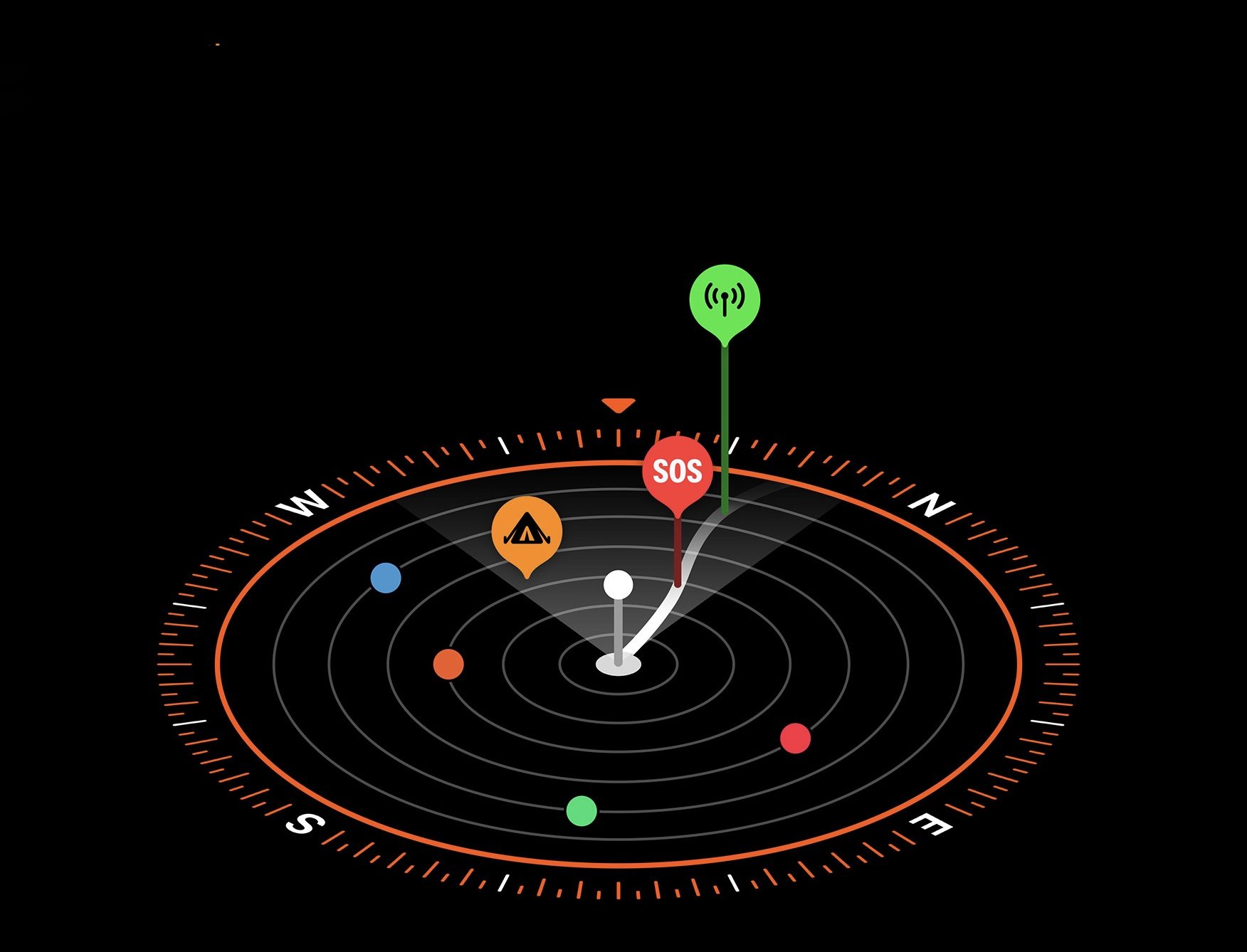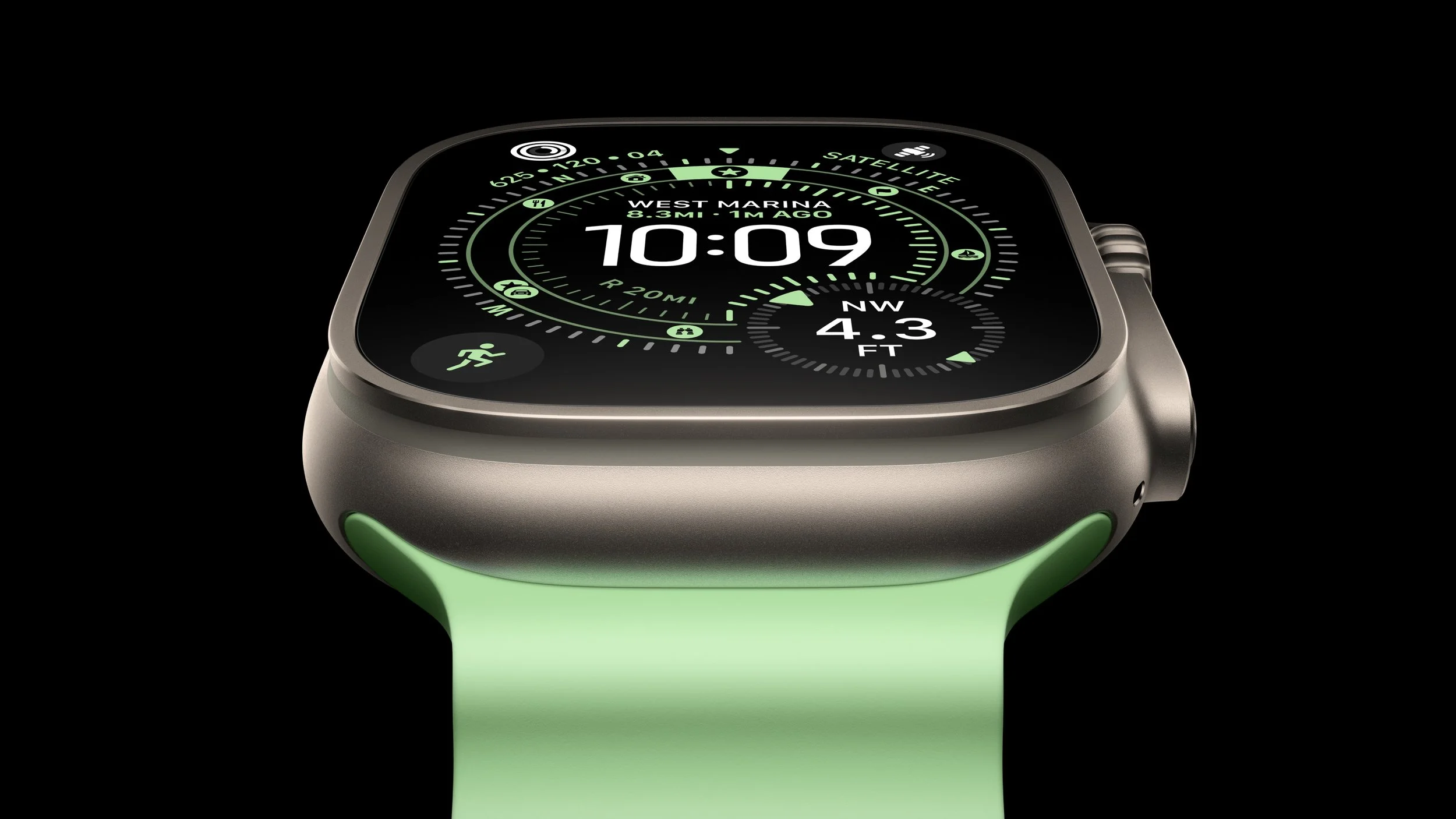Gear Review: Apple Watch Ultra

When Apple announced the Apple Watch Series 8 in September there were rumours that they might also announce a watch more oriented for athletes. The general rumour mill thought that it was to have better waterproofness, but ultimately no one knew what it was going to look like. Whispers said that Apple would break from the design that they have used since Jony Ive designed the very first Apple Watch, but instead they leaned into it and cranked up the size to 49mm. So what does the Apple Watch Ultra offer, especially over a regular Apple Watch that would make you consider it? Let’s start with why I wear an Apple Watch and branch out from there…
I think if you’ve never worn a smart watch you might have the impression that either…
A) it’s not for you or…
B) you would utilize it like a teeny tiny phone and constantly launch apps or try to type on a tiny screen. You might picture yourself watching YouTube while waiting for your morning coffee to brew
The truth is, it’s neither. I’ve been using Apple Watches since the first model and have always found them indispensable. There is no better way to…
receive notifications without disturbing anyone around you. This ranges from text messages, to e-mails, to automatically transcribed voicemails.
quickly see what is happening without fishing around in your pocket for your phone
quickly replying to incoming messages
receive relevant information at a glance such as time, upcoming events, the weather, and the time of the next sunrise/sunset (relevant to me as both a photographer and an outdoors enthusiast)
make or receive phone calls
ask or tell Siri something
see my fitness level/goals for the day and how I’m fairing
track the length of a hike
Remotely trigger my iPhone to take photos
Cause my iPhone to emit an audible pinging noise when I can’t find it
use ‘tap to pay’ to securely use my debit or credit card through the watch itself
see a whole host of notifications from various apps that range from sports scores as they happen, to breaking news. This doesn’t even include passive things that you never think of that the watch is doing such as monitoring your heart health or automatically calling emergency services after a bad slip/fall and you become unresponsive
I would think those things alone would make it a good sell, especially if you’ve embraced a digital lifestyle… but how would it integrate into an outdoors lifestyle? A type of lifestyle that usually pushes back on gadgets or ‘being connected’ (aside from a GPS unit). While the Apple Watch Ultra does offer cellular connectivity (via a monthly add-on subscription through your cell phone carrier usually for around $10/month) I didn’t activate this option. The watch wirelessly tethers with your iPhone and since I always have it with me, there was no need to have two cellular connected devices.
So in addition to everything that I’ve mentioned (and even more features I’m sure I forgot), here’s what I really liked and disliked about the additional features of the Ultra.
The titanium case: I have small wrists and worried that it would be way too big and clunky, or a constant bother and getting caught when wearing multiple layers of clothing. It turns out that Titanium is quite the engineering marvel. Not once have I regretted the size, it feels incredibly light and it has stood up to all the bonks and scrapes from my outdoor pursuits without showing a single blemish so far. The edge of the case is completely flush with the flat sapphire front crystal in an effort to protect the screen as well. The titanium itself offers corrosion resistance from any moisture or dips in the water, is water resistant to 100m, offers IP6X dust resistance and has been tested to MIL-STD 810H a military-level durability standard.
The strap: I chose the ‘Alpine loop’ (which comes in either orange or green) and not because I climb or have aspirations to mountaineer in any fashion, but rather I chose it because I love the g-hook (which harkens to other gear that I own) and bright orange colour. The strap is very well designed offering multiple size options allowing you to enlarge or tighten it depending on the outdoor temperatures and how snug you wish to wear it. I marvel at how the reinforced loops are actually woven into the strap itself offering a very secure strap that is woven from one continuous piece of nylon (no bonding glue here). We found that cleaning the strap was easy too with a nylon brush.
Another nice feature is that the g-hook is larger than where the strap feeds through the watch so there is never fear of it accidentally falling off your wrist as long as you have fed your hand through it.
Battery life: possibly one of the best perks of the larger watch… a larger battery. I could get a day and a half with my Apple Watch Series 7 while getting three days without issue on my Apple Watch Ultra. Tracking an all-day hike on my Series 7 would test whether I would make it back to my tent before the battery ran out where as on the Ultra I can use turn-by-turn navigation to get to the trailhead hours away, track my entire day of hiking and settle in for the night having only used a third of my battery power.
While it is remarkable for an Apple Watch user, I’m sure Garmin watch users are chuckling at this since they have multiple weeks of battery life. If battery life is the determining factor in your watch purchasing decision, I guess you will have to weigh whether you want to bring battery chargers with you on your journey. For me, I usually bring one big battery back which charges my phone, watch and video camera batteries as need be.
Since watchOS 7, your Apple Watch learns from your daily charging habits to try and improve the lifespan of your battery. The Apple Watch Ultra offers a new feature called ‘Optimized Charge Limit’ which again learns from your daily charging habits to determine when to charge to an optimized limit and when to allow a full charge. Fantastic news to maximize the overall battery life.
An upcoming update will also unlock the full potential of 60 hours of battery life by operating in a ‘low-power’ mode which is the perfect for canoe tripping as wi-fi and cellular capabilities are wasted.
Make sure you upgrade to WatchOS 16.1 as well as they have increased the battery life for ‘hiking’ workouts.
Action button: I really respect Jony Ive (and in turn Dieter Rams) and his design philosophy. Clean simple design can transform how you use something and the original Apple Watch only had two buttons. The addition of the Action button was quite a surprise to see and so far has been quite useful. I’d also light to highlight that unlike many outdoors watches there is not a single piece of text anywhere on the case denoting that you need to ‘press here’, or even what the button does. Simplicity is the best form of design and it shines here.
You can program the Action Button to perform a variety of tasks…
Workout
Stopwatch
Waypoint
Backtrack
Dive
Flashlight
Shortcut
there is also an option to activate the siren if you ‘press and hold’ (under ‘settings’)
and for me, I’ve set it to drop a waypoint. It’s been extremely useful to mark put-ins, portages and campsites so that I can tell at a glance just how much further I have to push during a windy day, or estimate how late it will be before I complete a double carry.
Siren: From hiking to canoeing if you were to ever to get injured, the rule of thumb is to always have a whistle with you when in the backcountry. There’s no better way to signal for help and the sound carries pretty far. The 86-decibel siren feature is a pretty helpful addition to the watch that can be heard up to 180 metres away (600 feet and will repeat without any need for repeated puffs of air.
GPS: Ever since the Series 2 Apple Watches have had L1 GPS functionality (the altimeter arrived in Series 3) which was decently accurate. A precision dual-frequency GPS (L1 and L5) was added to the Apple Watch Ultra, which doesn’t have interference from other radio waves and has a stronger signal that doesn’t run into reflection problems due to solid objects such as the ground or hills.
Overall I found my location accuracy to be a fair bit more precise when going for hikes. When hiking my favourite 3KM trail, the gentle tap that I would receive to indicate I had walked one kilometre was pretty much the exact same spot every time on my Ultra, whereas it would fluctuate a bit on my Apple Watch 7. Out of curiosity I wore my wife’s Apple Watch 4 and my Ultra at the same time while going for the same 3 KM hike and I would have an average discrepancy of 0.1 km between the two.
This might not be the biggest issue in the world and might be more of a concern if you are a runner. Where I found the accuracy handy however was with the ‘backtrack’ feature. When going for hikes, fire up the ‘Compass’ app and start recording your route. When you’re ready to head back use the ‘retrace steps’ feature and it will give you a route from all the breadcrumbs that it recorded along the way.
It’s pretty easy to loose sight of the trail when hiking in autumn as the falling leaves obscure the path, but using the backtrack feature (which is accurate to within 5m) it won’t matter how poorly signed the trails are, you will be sure to make it back to the trailhead.
Brightness: The always-on display is incredibly bright at 2000 nitts (twice as bright as previous Apple Watches). This also goes for one of the watch’s unsung features… the flashlight. The amount of times I swipe up and activate the flashlight to try and find something in the dark is quite often. The boost in brightness is a huge help. To top it off, if you swipe left while the flashlight is activated, you can toggle between white light and red light, which is great for saving your eyesight while trying to find things in your tent or at the bottom of your portage pack at night. Don’t expect the red mode to be bright enough to navigate a trail however. You’ll still end up stumbling over roots due to the light falloff.
Another cool feature is when you rotate the Digital Crown to activate Night Mode when using the ‘wayfinder’ watch face. Again, it’s easy on the eyes while still crisp enough to read all the information.
Other neat features:
Speaking of the ‘wayfinder’ watch face, if you tap the screen it alternates between the hours of the day, and a fully functional compass along with your latitude and longitude.
In the compass app if you scroll the Digital Crown in and out, you will cycle though useful information such as the compass degrees, elevation/incline/latitude/longitude, and a breadcrumb visualization of your route so far.
When you hit the ‘action button’, you have the option to choose from a long list of icons to help clarify what each point of interest signifies.
The Series 8 and Ultra watches both have a new feature that detects if you have been in a car accident and will automatically call emergency services.
I found that the Taptic Engine in the Ultra to be a lot stronger than my previous watches.
Apple added the ability to track a ‘paddling’ workout. Not that I’m suggesting that you make your canoe trip into an exercise regiment, however it is pretty nifty to see just how long the lake was that you paddled so you will know how long it will take you to get back to your vehicle.
I honestly don’t have anything to gripe about regarding the watch. I think all of my complaints/suggestions come down to watchOS itself.
The watch doesn’t seem to retain more than a single day’s worth of weather data which is a real shame because there is some really wonderful granular data that would be useful on a long trip. Rainfall and wind speed are two I use frequently but the moment you flip it to ‘Airplane Mode”, poof it disappears. The iPhone’s iOS has the same issue as well.
WatchOS should have a “tap and hold” to end a workout. The icons for controlling workouts are too close together and it is too easy to end a workout rather than pause it. Having a more deliberate interaction with the screen would solve this issue.
WatchOS always notifies you when you’re on a walk to start a workout. It doesn’t however ask you if you want to end a workout. Even after hiking an average pace for a few hours then hoping in a vehicle that’s moving at 80km/hr doesn’t cause your watch to say “wait a minute…”.
WatchOS asks every single time if it is allowed to use your data to do backtrack. I would love an option to “always allow”.
Conclusion
I think if you’ve been considering an Apple Watch Ultra and see it being useful in your outdoorsy lifestyle, I highly recommend getting one. It is chock full of features that you will already use in your day-to-day life, while really shining as soon as you step out of your vehicle in the outdoors.
If you’re on the fence though, I’d wait until the second generation. As with every Apple device, each generation gets more refined, and by the time the next version comes out watchOS will have improved to take full advantage of the hardware. Maybe we will see the ability to import maps and have even more features added to it.
It’s nice to see Apple really take the watch from a fashion piece with the initial models to finding a real niche with it and embracing the outdoors. With the advent of SOS capabilities via satellite with the new iPhone, all of the sudden these devices that you might not think of as rugged or useful in the backcountry are being invaluable.










